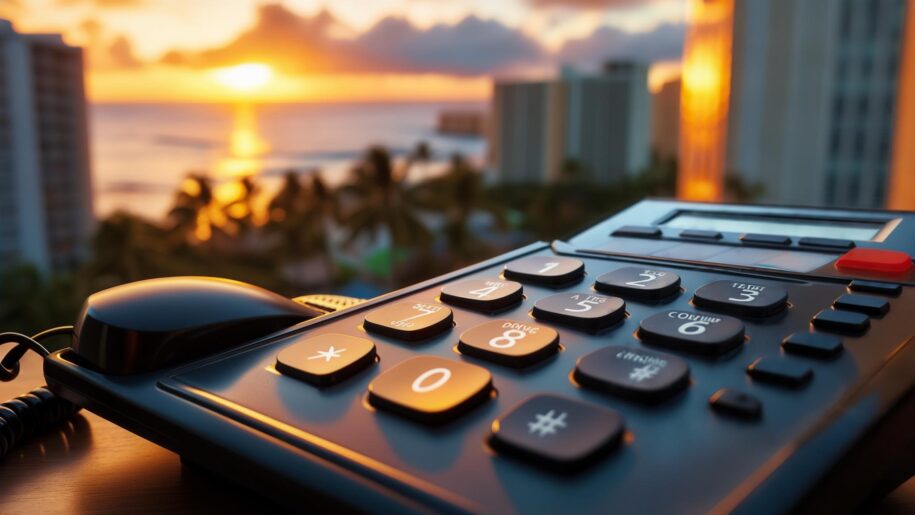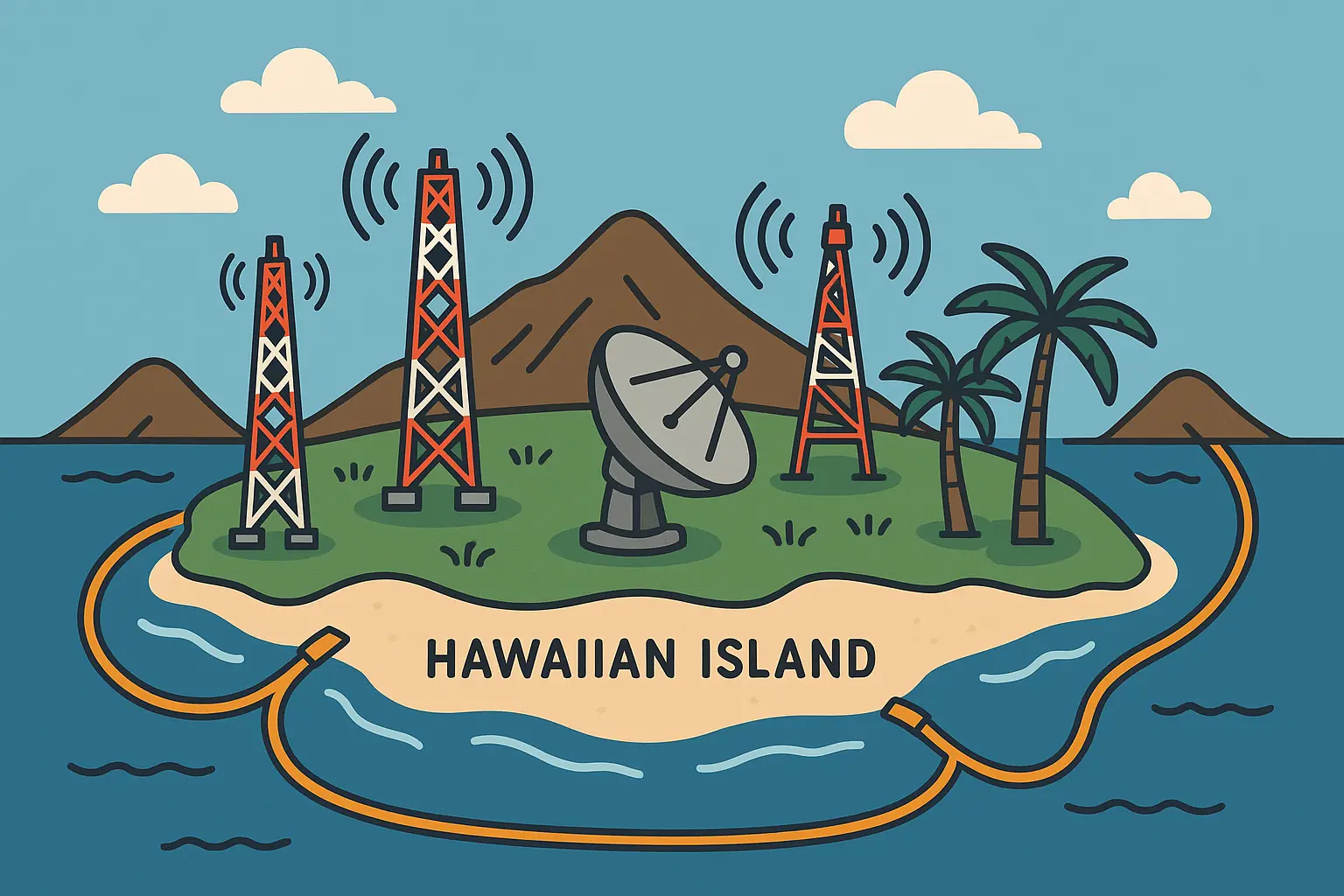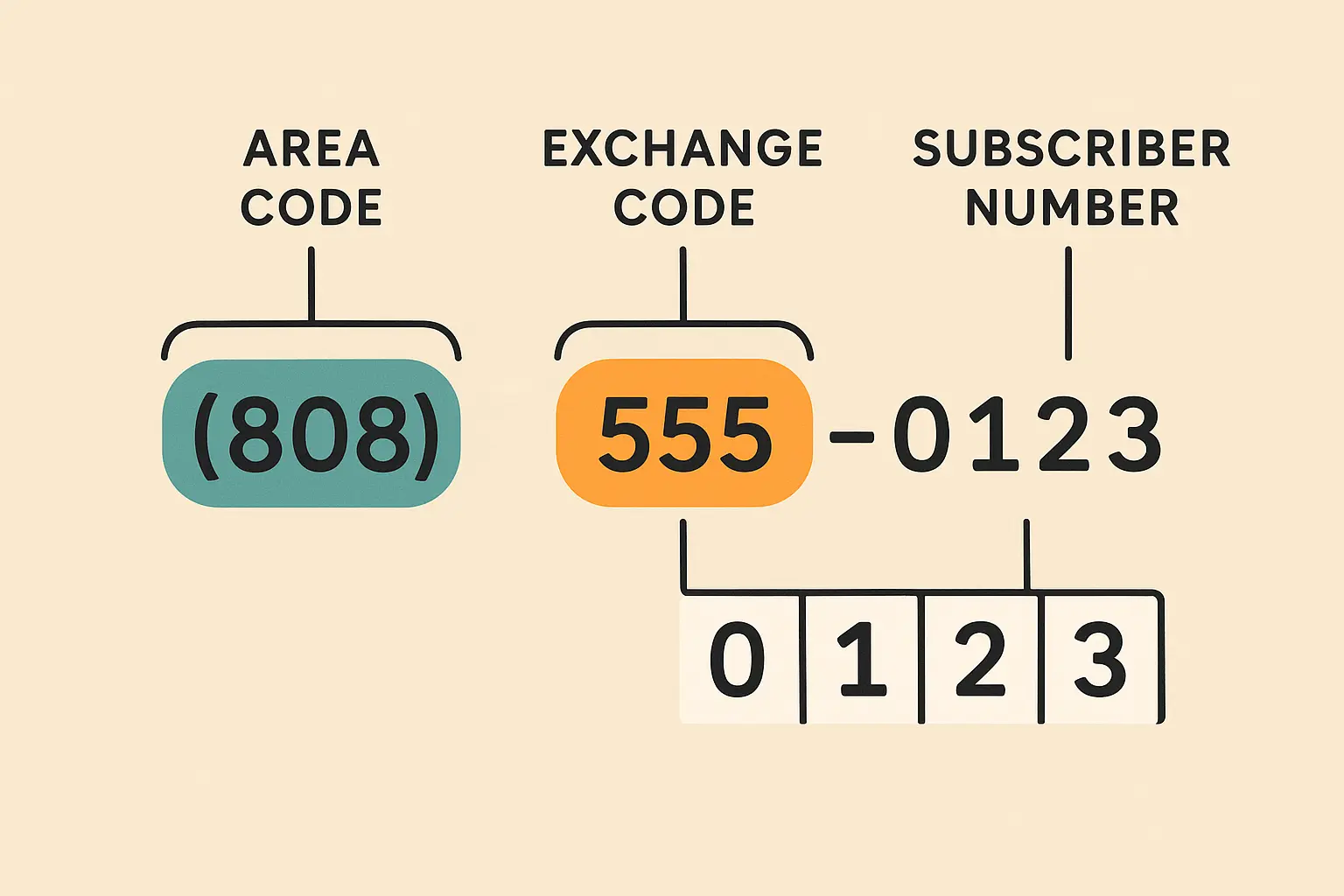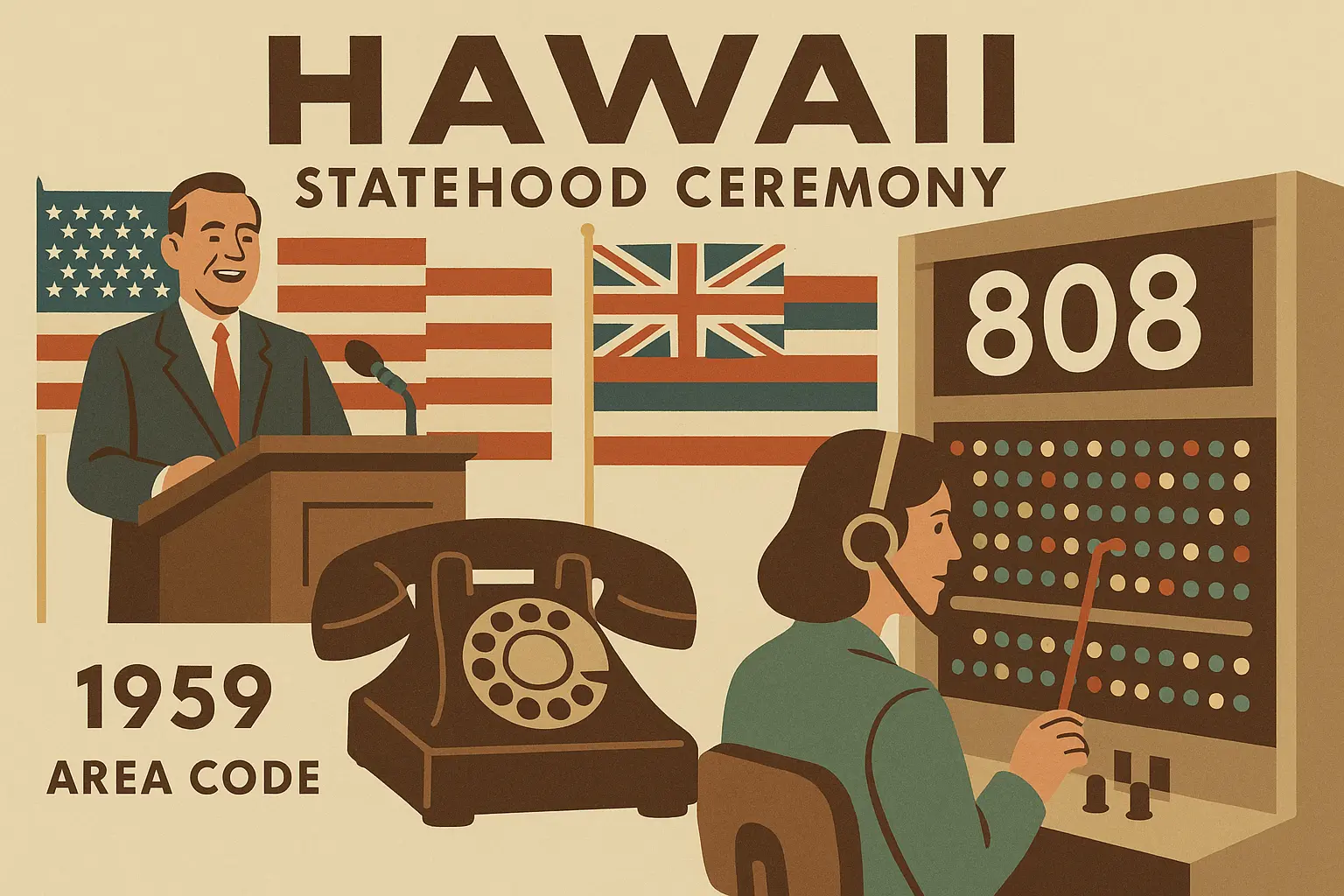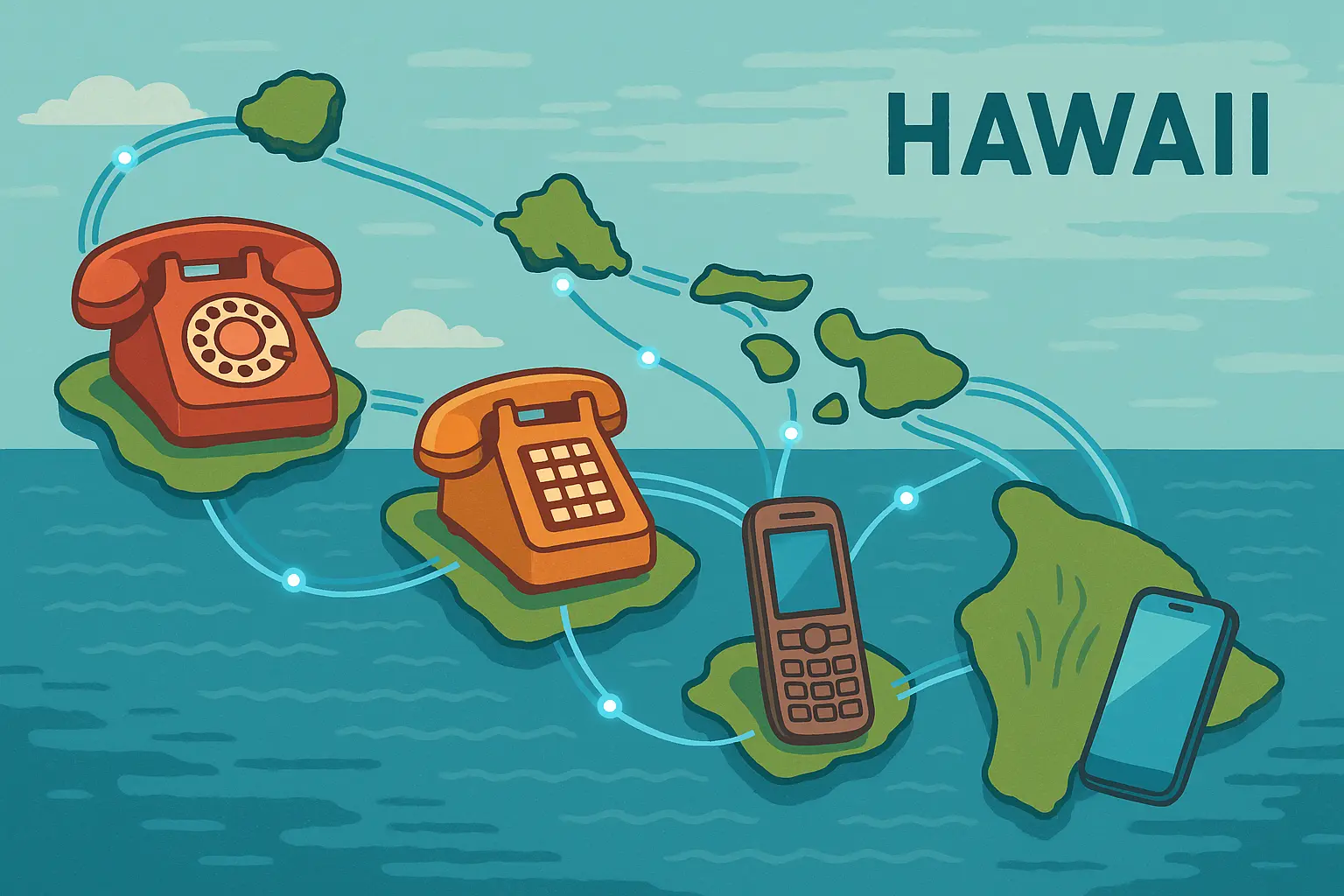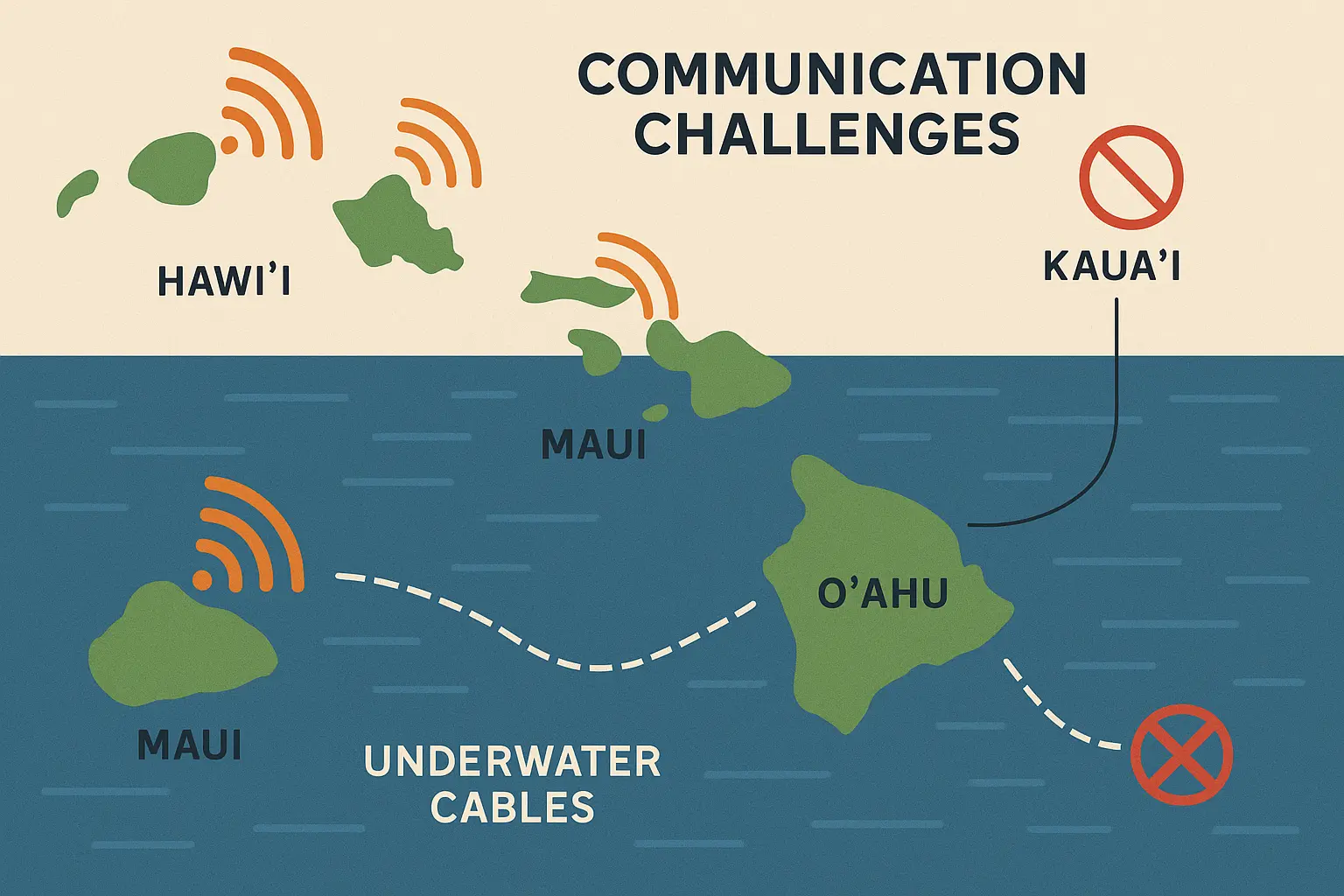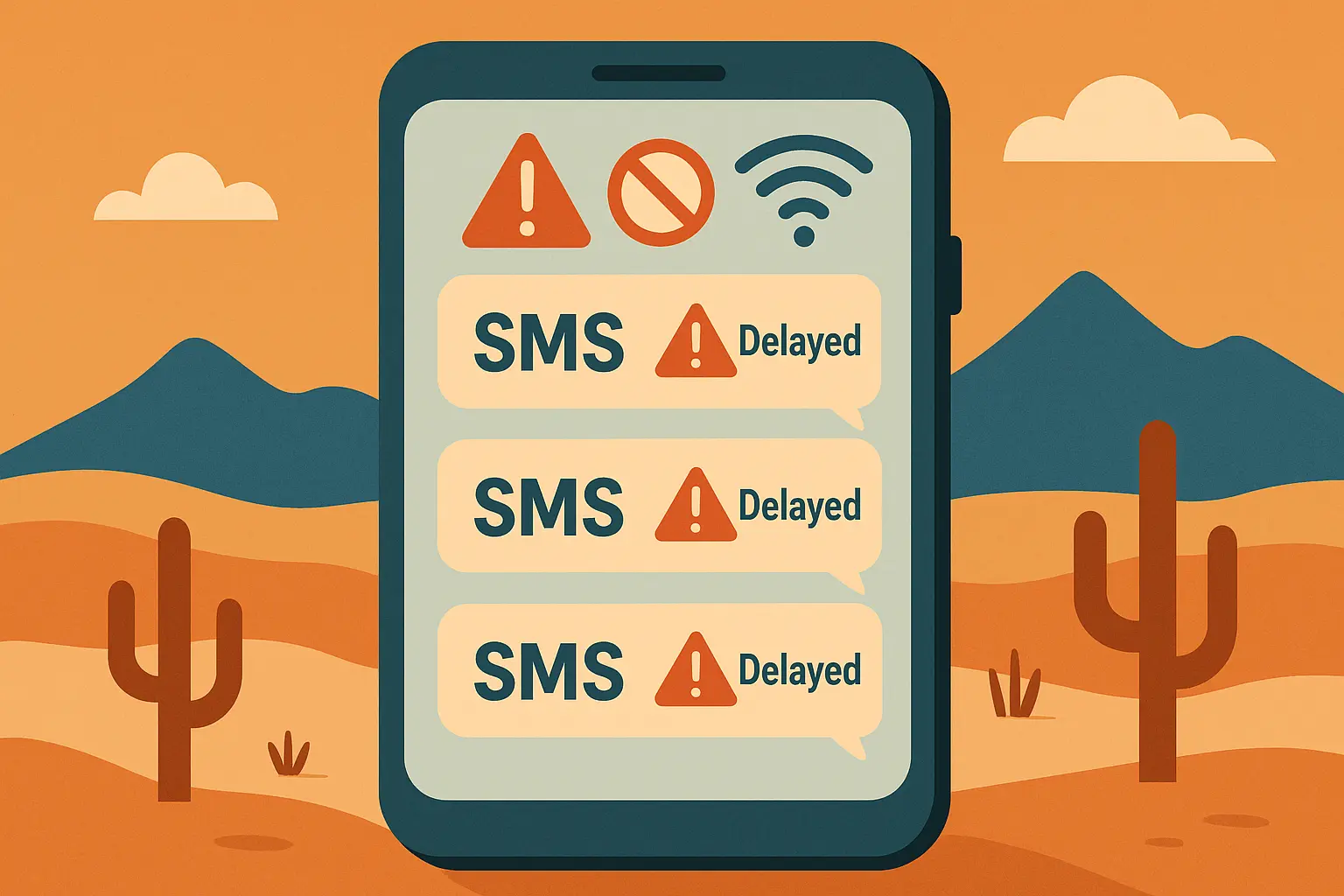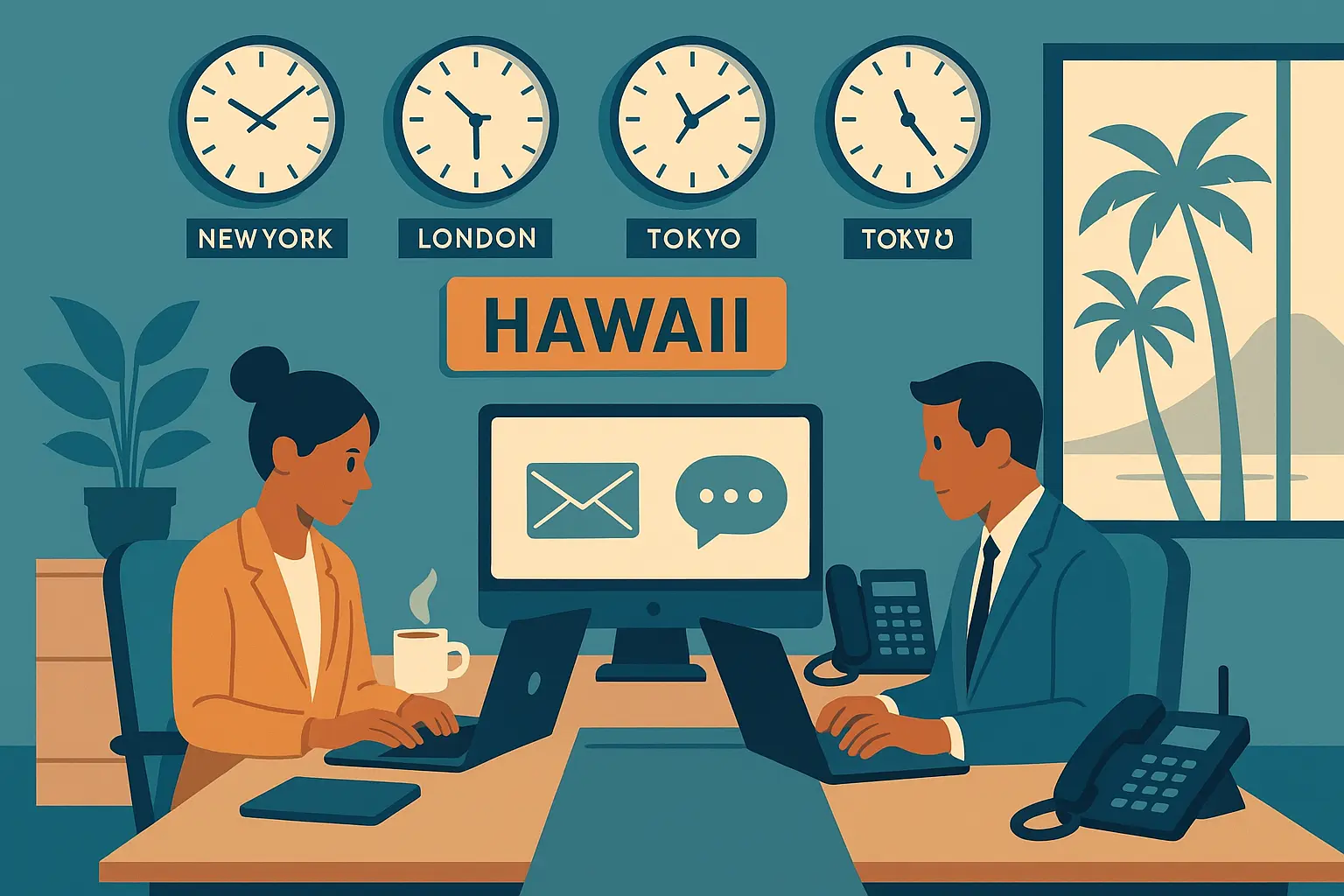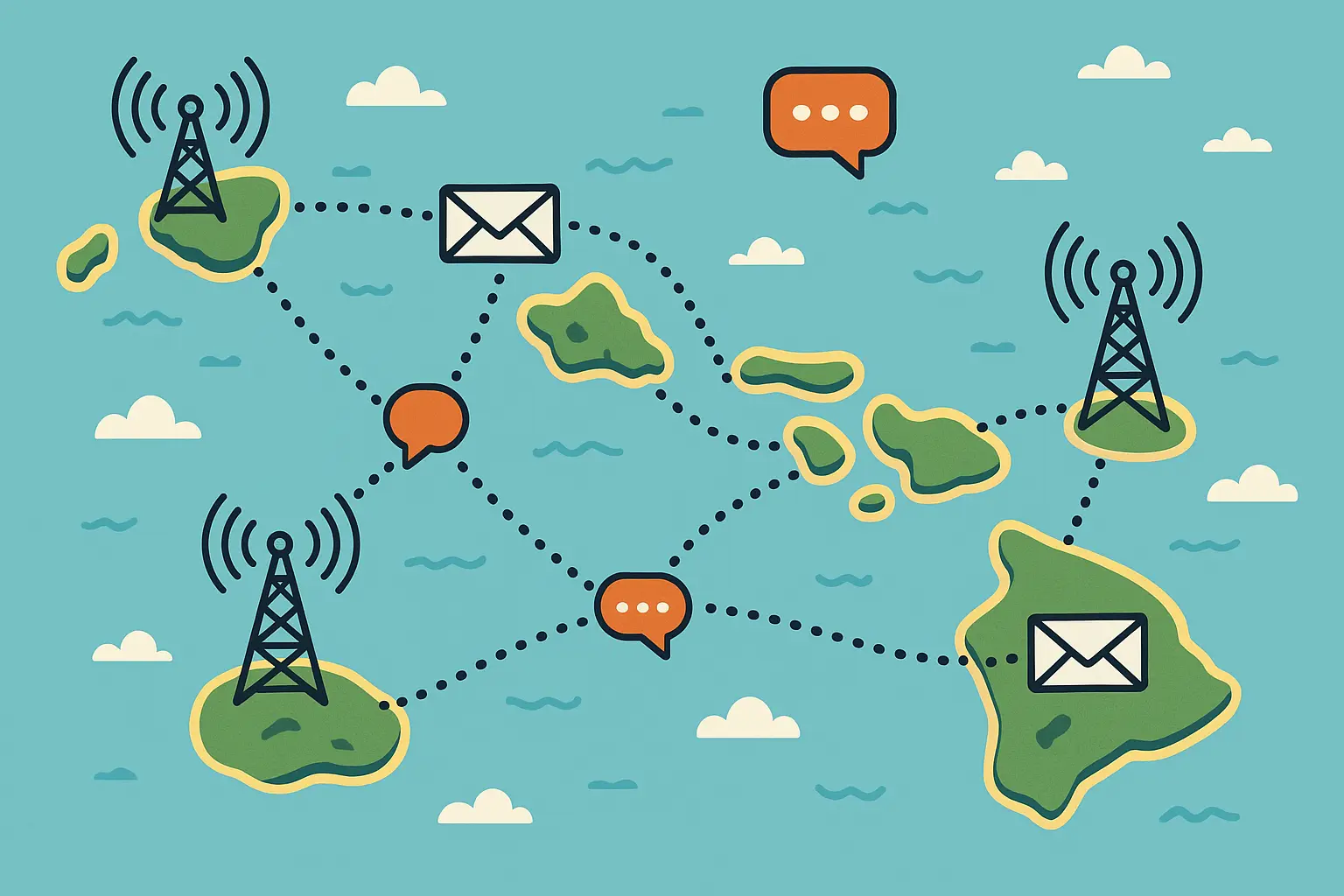Hawaii is the only U.S. state that fits under a single area code. While California juggles 30+ different codes, all of Hawaii – from bustling Honolulu to remote island ranches – shares just three digits: 808.

Table of Contents
Table of Contents
-
Hawaii’s One-Code Wonder
-
What Your 808 Number Actually Tells People
-
How Hawaii Got Stuck with One Area Code
-
Why Island Phone Service Can Drive You Crazy
-
Keeping Your Messages Flowing in Paradise
TL;DR
-
Hawaii runs on one area code (808) for all islands – no other state does this
-
Every 808 number runs on Hawaii time, which never changes (no daylight saving)
-
The system dates back to 1959 when Hawaii became a state
-
Being in the middle of the Pacific creates real headaches for texting and calling
-
Smart solutions exist to keep your messages reliable across the islands
Hawaii’s One-Code Wonder
Most mainland states are chopped up into multiple area codes based on population and geography. Hawaii said “nah” to that approach and kept things simple. Whether you’re calling a Waikiki hotel or a coffee farm buried in Kauai’s mountains, you’re dialing 808.
This setup covers every single Hawaiian island, from the million-person metropolis of Honolulu to Niihau (the “Forbidden Island” where hardly anyone lives). When Hawaii needed to plug into America’s phone system back in 1959, officials decided to treat the whole island chain as one big telecommunications territory.
The decision makes sense when you think about it – Hawaii is already isolated by thousands of miles of ocean, so why complicate things with multiple area codes? But this simple approach creates some interesting challenges that most people never consider.
Every Island, Same Code
Unlike mainland states where area codes follow county lines or population centers, Hawaii treats all eight main islands as one unit. Your 808 number works the same whether you’re on crowded Oahu or sparsely populated Molokai.
But here’s where things get interesting – just because they all share 808 doesn’t mean the experience is the same everywhere. Oahu, packed with nearly a million people, has robust cell towers and fiber optic cables. Meanwhile, places like Lanai rely on microwave towers and satellite connections that can get flaky during bad weather.
The islands don’t compete for different area codes, but they definitely compete for infrastructure attention. Honolulu gets the good stuff first, while outer islands sometimes feel like telecommunications afterthoughts.
|
Hawaiian Island |
Main Towns |
Population |
Connection Quality |
|---|---|---|---|
|
Oahu |
Honolulu, Pearl City |
High |
Excellent |
|
Maui |
Kahului, Lahaina |
Medium |
Good |
|
Big Island |
Hilo, Kona |
Low |
Fair |
|
Kauai |
Lihue, Kapaa |
Low |
Fair |
|
Molokai |
Kaunakakai |
Very Low |
Spotty |
|
Lanai |
Lanai City |
Very Low |
Spotty |
Honolulu Hogs the Numbers
As Hawaii’s biggest city, Honolulu gobbles up a huge chunk of available 808 numbers. Nearly a million people live in the metro area, plus all the businesses, government offices, and tourist operations that need multiple phone lines.
This creates a weird situation where a Honolulu company can easily snag several memorable 808 numbers for different departments, while a similar business on Molokai might struggle to get even basic phone service. The infrastructure just isn’t there to support the same level of service across all islands.
Most inter-island calls actually bounce through Honolulu’s switching centers first, even when you’re calling from Maui to the Big Island. Your call might travel hundreds of extra miles just to connect two islands that are only 30 miles apart.
A Honolulu restaurant might have 808-555-FOOD for reservations and 808-555-TAKE for takeout orders, while a similar restaurant on Molokai considers themselves lucky to have any 808 number that actually works reliably.
Remote Islands, Real Problems
The smaller Hawaiian islands face telecommunications challenges that would make most mainland residents lose their minds. Sure, they get 808 numbers just like everyone else, but actually using those numbers can be an adventure.
Places like Molokai and Lanai depend on microwave towers and satellite links to stay connected to the main network. When this equipment breaks down – and it does, thanks to salt air, tropical storms, and general remoteness – entire communities can lose phone service despite having perfectly valid 808 numbers.
Even some of Hawaii’s uninhabited islands get 808 coverage for research stations and military installations, though these connections often require specialized equipment that costs more than most people’s houses.
Time Zone Reality Check
Every 808 number runs on Hawaii-Aleutian Time, and here’s the kicker – Hawaii doesn’t do daylight saving time. Ever. While the mainland springs forward and falls back twice a year, Hawaii just keeps chugging along at the same pace.
This creates a moving target for anyone trying to coordinate with the mainland. During standard time, Hawaii is three hours behind the West Coast and six hours behind the East Coast. When the mainland changes their clocks, those gaps become four and seven hours respectively.
Mainland businesses constantly mess this up, scheduling calls during their normal hours and forgetting that 2 PM Eastern means 8 AM in Hawaii. That might work for early risers, but it definitely catches people off guard.
Quick Time Zone Survival Guide:
-
Hawaii is always 3-4 hours behind the West Coast (depends on their daylight saving)
-
Schedule mainland calls between 7 AM – 3 PM Hawaii time for normal business hours
-
Set up auto-replies explaining Hawaii time when you’re out of office
-
Use scheduling apps that show multiple time zones
-
Just accept that you’ll do math every time you plan a call
What Your 808 Number Actually Tells People
Back in the day, your phone number actually told people which island you lived on. Different three-digit combinations after 808 were assigned to different islands based on population and infrastructure needs. A 234 exchange usually meant Honolulu, while 553 probably meant Kauai.
These days, those patterns don’t mean much anymore. Thanks to number portability, you can move from Oahu to Maui and keep your old number. So that 808-234-5678 number might belong to someone who moved to the Big Island years ago but didn’t want to change their digits.
The system evolved from simple geographic assignments to a more flexible approach that lets people keep their numbers when they move. It’s more convenient for users, but it makes the old island-identification tricks pretty useless.
Exchange Codes: The Old Island Map
The original 808 system assigned specific number ranges to different islands, creating a logical map that phone company engineers could follow. Oahu got multiple ranges because of its size and importance, while smaller islands shared codes or got smaller allocations.
Modern telecommunications have scrambled these traditional patterns pretty thoroughly, but you can still see traces if you know what to look for. The really rigid assignments – like military installations – stay put, but civilian numbers move around freely.
Understanding proper phone number formatting becomes important when you’re dealing with international business or coordinating travel between Hawaii and mainland operations, especially since Hawaii’s unique position can confuse automated systems.
|
Exchange Range |
Original Island |
Current Reality |
|---|---|---|
|
808-2XX |
Oahu (Honolulu) |
Mixed everywhere |
|
808-3XX |
Big Island |
Mostly still there |
|
808-4XX |
Maui County |
Partially maintained |
|
808-5XX |
Kauai |
Mostly still there |
|
808-6XX |
Oahu (suburbs) |
Mixed everywhere |
|
808-7XX |
Military |
Strictly controlled |
Mobile Meets Landline
Hawaii’s 808 system doesn’t care whether you’re calling a cell phone or a landline – they all use the same number format. Unlike some mainland areas where you can guess the service type from the number, 808 numbers keep you guessing until someone picks up (or doesn’t).
This actually works pretty well for Hawaii residents who frequently switch between different types of phone services. Whether you’re upgrading from grandma’s old landline to a smartphone or switching carriers entirely, your number stays the same.
The network figures out how to deliver your call behind the scenes, so you don’t need to learn different dialing patterns or remember special prefixes. It’s one less thing to worry about in an already complicated system.
How Hawaii Got Stuck with One Area Code
When Hawaii became the 50th state in 1959, phone company engineers had a unique problem: How do you connect a bunch of islands in the middle of nowhere to the rest of America’s phone system? Their solution was pretty clever – give the whole state one area code and figure out the technical stuff later.
This decision wasn’t just about convenience. Hawaii’s geographic isolation meant that traditional mainland approaches wouldn’t work. You couldn’t just extend existing phone lines or add another switching center down the road. Every connection required massive infrastructure investments across thousands of miles of ocean.
The 808 assignment became more than just a phone number prefix – it turned into a symbol of Hawaiian unity and connection to the mainland United States, even when that connection was literally hanging by underwater cables.
Statehood Meets Phone Company Reality
Integrating Hawaii into the mainland phone system required some serious engineering creativity. The islands needed enough numbering capacity for future growth, simplified routing for mainland callers, and a system that could handle Hawaii’s unique geographic challenges.
The planners couldn’t just copy what worked on the mainland. They needed submarine cables, upgraded switching equipment, and trained operators who understood the new system. The 808 assignment represented the end result of years of planning and millions of dollars in infrastructure investment.
Getting all this to work meant that early Hawaii phone service was expensive and sometimes unreliable, but it was still better than the alternative of being completely cut off from mainland communications.
From Analog to Digital Paradise
Hawaii’s jump from old-school analog phone systems to modern digital technology brought huge improvements, though new tech usually arrived later than on the mainland. Being in the middle of the Pacific meant Hawaii often got the latest innovations months or years after everyone else.
Digital switching made possible all the features we take for granted now: call forwarding, voicemail, caller ID, and number portability. These advances made location less important for phone service, since calls could be routed more efficiently regardless of which island you were actually on.
The infrastructure upgrades also improved reliability across the islands, reducing the connection problems that had plagued inter-island calls during the analog days. Modern fiber optic cables and satellite systems now provide backup pathways, ensuring better service even when equipment needs maintenance or weather hits.
Why Island Phone Service Can Drive You Crazy
Living with an 808 number comes with frustrations that mainland phone users never experience. Hawaii’s geographic isolation creates communication problems that go way beyond time zone differences or long-distance charges.
The 808 system covers over 1,500 miles of Pacific Ocean, creating dependencies on infrastructure that most people never think about. When that infrastructure hiccups, entire communities can lose connectivity despite having perfectly good phone numbers.
These problems affect everything from daily personal calls to critical business operations. Hawaii residents learn to develop backup communication strategies that seem paranoid to mainland users but make perfect sense when you understand the realities of island life.
When Islands Don’t Want to Talk to Each Other
Communication between Hawaiian islands relies on submarine cables and satellite connections that create weird vulnerabilities. These connections handle phone calls, internet traffic, text messages, and data services that modern life depends on – and they all share the same fragile infrastructure.
When maintenance windows happen or equipment fails, the effects ripple across the entire 808 system. Here’s the really annoying part: calls between islands sometimes route through mainland switching centers before coming back to Hawaii. So your call from Maui to the Big Island might bounce through California first, creating delays and quality issues that make no geographic sense.
Ever tried calling your friend on the Big Island from Oahu, only to have your call sound like it’s coming from Mars? Welcome to island life, where 30 miles of ocean can be harder to cross than 3,000 miles of continent.
For Hawaii residents dealing with these connectivity headaches, learning how to forward text messages to email can provide reliable backup communication when cellular service between islands gets flaky during maintenance or weather events.
Text Messages That Take the Scenic Route
Hawaii’s location in the middle of the Pacific creates frustrating delays with text messaging that can drive you absolutely nuts. The same infrastructure problems that affect voice calls also mess with SMS delivery, sometimes causing messages to show up hours after they were sent.
These delays become especially maddening during emergencies or when you’re trying to coordinate time- sensitive plans. The 808 system handles millions of text messages daily, but the routing complexity means some messages get stuck in digital traffic jams or experience delivery failures that require multiple attempts.
Weather makes everything worse. When storms hit and satellite connections get unreliable, SMS problems often last longer than voice call issues since text messages use different routing protocols that don’t have the same backup systems.
Keeping Your Messages Flowing in Paradise
For Hawaii residents and businesses using 808 numbers, you can’t just hope your messages arrive when they’re supposed to. The islands’ unique communication challenges require more proactive management than most mainland users realize.
Whether you’re running a business that depends on customer communications or just trying to stay connected with family across different islands, having backup systems can save you from missed opportunities and communication failures that come with island life.
Modern forwarding services can bridge the gap between Hawaii’s geographic challenges and reliable communication needs, providing solutions that work even when traditional SMS delivery takes an unscheduled vacation.
Business Life Across Time Zones
Hawaii businesses face communication nightmares when dealing with mainland clients and partners. Operating in a completely different time reality from the rest of the United States creates scheduling disasters and missed communication opportunities that can seriously damage business relationships.
The challenges go beyond simple time zone math. Hawaii businesses must coordinate with partners who may be starting their day when Hawaii is still asleep, or wrapping up when Hawaiian businesses are hitting their stride. This creates communication gaps that require careful planning and automated systems to bridge effectively.
If you’re doing business with the mainland, just remember – when they’re having lunch, you’re probably still drinking your morning coffee. Set expectations early and save everyone some headaches.
Hawaii businesses can streamline their workflow by implementing SMS forwarding to Slack channels, allowing teams to manage messages efficiently across different time zones and maintain collaboration with mainland partners.
Time Zone Survival Checklist:
-
Install world clock apps showing Hawaii, Pacific, and Eastern time
-
Put current Hawaii time in your email signature
-
Use scheduling tools that convert time zones automatically
-
Create operating hours documentation for mainland clients
-
Set up emergency contact protocols for urgent after-hours stuff
-
Train your team on time zone etiquette
Travel and Staying Connected
When 808 users travel between islands or to the mainland, keeping reliable message access becomes essential. The system works differently when you’re moving between coverage areas, and standard cellular roaming doesn’t always provide the reliability that Hawaii residents need.
Auto Forward SMS provides a solid solution by automatically forwarding all incoming text messages to email addresses, ensuring important communications reach you even when cellular reception gets spotty between islands or during mainland travel. The service detects connectivity issues and keeps message copies until successful delivery – particularly valuable for 808 users dealing with intermittent coverage.
With URL forwarding capabilities, you can integrate SMS communications with platforms like Slack or Teams, maintaining seamless communication flow whether you’re in Honolulu or traveling. Starting at just $1.30 per month, it’s an affordable solution for Hawaii residents who need reliable SMS management for their communications.
For first-time users setting up message forwarding for their 808 numbers, the comprehensive guide on getting started with AutoForward SMS provides step-by-step instructions specifically helpful for Hawaii residents managing communications across multiple islands and time zones.
Travel Communication Setup:
-
Set up SMS forwarding to email before inter-island trips
-
Download offline maps for areas with poor coverage
-
Have backup communication methods ready (email, messaging apps)
-
Warn contacts about potential delays during island hopping
-
Test your forwarding setup before critical travel
-
Keep a physical backup of important contact numbers
Android users with 808 numbers can learn how to forward text messages on Android devices to ensure reliable communication backup when traveling between Hawaiian islands or to the mainland where connectivity varies.
Final Thoughts
Living with an 808 number means dealing with quirks that most Americans never think about. From time zone math that changes twice a year (thanks to everyone else’s daylight saving) to text messages that sometimes take the scenic route through California, Hawaii’s phone system has its own personality.
But here’s the thing – when your “local” area code covers paradise, a few dropped calls and delayed messages seem like a fair trade-off. The 808 system connects every corner of Hawaii under one simple code, creating a unified telecommunications identity that matches the islands’ spirit.
Whether you’re a Hawaii resident navigating inter-island connectivity challenges or a business managing communications across multiple time zones, understanding these realities helps you plan better and stay connected. The islands’ geographic beauty comes with practical challenges, but smart solutions ensure you can stay in touch no matter where your island adventures take you.
